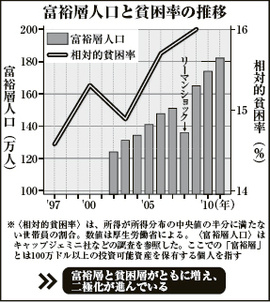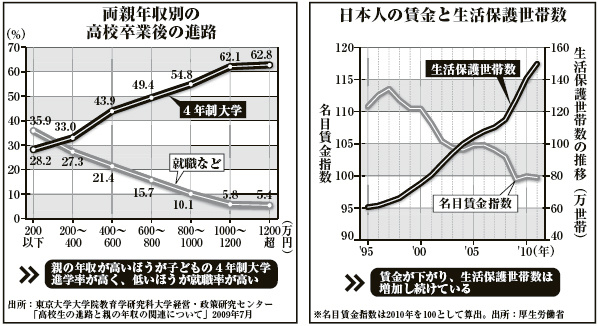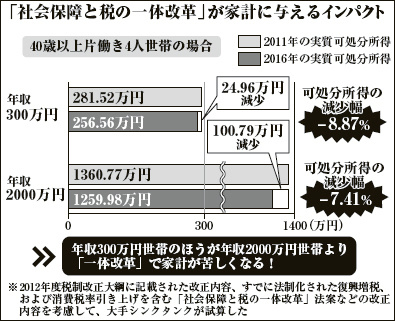The rich mistake the poor to be “lazy
people.” I do advise them to once try to
choose the poor as politicians or prime minister by lottery. I am assured that people chosen in such a way
will do much better than Kan,former prime minister and Noda, current prime
minister.
Masatoshi Takeshita
English translation of an excerpt of a
Japanese article: Anya Yakou ~ I Give A Thought To Collapsing Japan ~ August 22, 2012
[Article to Note] This Country Divided Into The Rich and The
Poor: New-Rich and New-Poor Like This
Japan once had an age called “age of all
Japanese belonging to the middle-class.”
Many households were called “middle-class” and all people lived an
average and uniform life in a good sense.
A “uniform” outlook on world exemplified by
this “age of all Japanese belonging to the middle class” fits to the mentality
of Japanese who dislike explicitly excessive competition but it is the “lack in
common sense” by global standards, hardly seen in the world.
The “gap between rich and poor” seen in
this article is very common in almost every country.
I lived in Southern American countries in
childhood because of my father’s work. It
is a sharp contrast between the town where the rich lived and the slum where
the poor lived that is imprinted on my memory as a child.
On weekends the children of the poor begged
for money surrounding the cars the rich family sat in.
Japan of “age of all Japanese belonging to
the middle class” in a good sense is “totally opposite” to the society I lived
in when I was a child. Especially since “globalism” or “global standard” was adopted under the
LDP/Koizumi administration, “global standardization” in a bad sense has been apparently
promoted at once and the situation called “polarization” has been accelerated.
Namely, Japan has not been divided into the
rich and the poor, but rather the “world specific to
Japan” rarely seen in other countries has collapsed and the bad practice of the
western countries has run rampant over Japan.
The result is the today’s “polarized” world.
In a word, Japanese characteristics have
been lost and the gap between the rich and the poor commonly occurring in other
countries has started to appear. It is
difficult to put back the clock again and “polarization” and “rich-poor gap”
will be widened to the same level as in Western counties.
We Japanese will be challenged by a future
never bright but poor.
(Comment by the blogger)
(Excerpt of a Japanese article: Shukan
Gendai “Blind Spot of Economics” – August 21, 2012 –
*This
country divided into the rich and the poor
Part
II: New-Rich and New-Poor Like This ~One out of six Japanese Poor and One out of 71 Rich
Confrontation
between new-rich and new-poor Has Started! ~
**********************************************************************
Transition of population of the rich and
poverty ratio
Polarization in progress; an increase of
the rich as well as the poor
Looking at the right (*upper) graph, you
will apparently see that new “millionaires” have come into existence every year
since 2002, except for 2008, the year of outbreak of Lehman’s fall.
“The rich with financial assets of more
than JPY 500 million are called “billionaires.”
There were 26,326 in 2009 and 34,879 in 2011. Most of them run medical corporations or law
firms. Furthermore, many people are
increasing their assets by inheriting them from their ancestors.
Approximately 90 percent of such people are
considered to hold real estate in some form or other. Approximately 10 percent among them are
owners of condominium buildings. As they
have the whole buildings, with high profitability, wealth produces wealth.” (Mr. Shotaro Kobayashi, Fuani Soken)
**********************************************************************************
left: Option in life after graduating from high
school by parents’ income
The higher the income of parents is, the
higher the percentage of graduates continuing on to four-year universities or colleges
is.
Source: University Management & Policy
Research Center, Tokyo University Faculty of Education: “Association between
option after graduating from high school and income of parents” July 2009
right: Japanese wages and number of families receiving public assistance
With a fall in wages, the number of
families receiving public assistance continues to increase.
Nominal wage index is computed with 2010 as
100.
Source: Ministry of Health, Labor and
Welfare
On the other hand, new-rich and new-poor
continue to mount, as mentioned the previous section. The relative poverty ratio (the percentage of
households with income of less than one-half of the median of income
distribution) stipulated by OECD (Organization of Economic Cooperation and
Development) was 14.9 percent in 2003 and 16 percent in 2009. This means that one out of about six Japanese
lives with income of less than one-half of the average income.
The number of people receiving public
assistance goes on increasing with approximately 2.11 million people (approximately
1.53 million families) as of March 2012.
The budget to allocate to them reaches the enormous amount of money: approximately
JPY 3.7 trillion.
It is highly likely that the number of
people receiving public assistance, a great burden to public finance, will
greatly increase. This is because the
new-poor have come into existence. What
are they like? Mr. Ryouhei Kawamura, the
secretary-general of NPO “POSSE” tackling the working poor issue, talks about
it.
“The people in question
are middle-aged and older part-time workers, mainly those in their 40s. They are non-regular employees and yet not
young. Most of them are said to be
unable to receive pension benefits in the future. Comparing them with the young working in the
same work place, they are in miserable situation. When the young consider such people to be
what they will be in the future, the young cannot try hard though their parents
or full-timer friends encourage them to “do their best at work.”
There were the poor in the past, too. However, the quality of poverty has greatly
changed. During the period of high
economic growth, people could expect to live a better life in the future though
they were poor and so they did not complain about low wages.
However, now once
they become the poor, they will be unable to get job or satisfactory food. They cannot expect better future. The new-poor people have profound despair
that hard work will not pay off.
*Exclusive
Towns where the rich alone live
In addition, poverty
causes vicious cycle. College Management
& Policy Research Center, Tokyo University Graduate School of Education has
released shocking data. The ratio of
advancing to four-year colleges or universities was 28.2 percent for children
born to parents with annual income of less than JPY 2 million. Thirty-five point nine percent of such
children opted to find employment after graduating from high-schools.
On the other hand, the
ratio was 62.8 percent for children born to parents with annual income of JPY
12 million. Only5.4 percent opted to
find employment.
Namely, annual income of
parents directly affects the academic background of children. Not individual efforts but
parentage determines social stratum. A feeling
of helplessness and a sense of stagnation have rampant over the whole society.
The areas where people with high annual
income live are filled with plans to build ultra-rich condominiums. European and American juggernauts have
invested funds to such plans. Mr. Arito
Oki, representative of Attractors Labo., says:
“It is easier to maintain asset value of a condominium
situated in a prime location in central Tokyo.
The rich who can afford to purchase expensive property are likely to
make a profit by resale.
When purchasing real estate, the rich never
compromise whatever it is for investment or for homes of their own. They will not purchase real estate situated
outside the Yamanote line with JPY 100 million, but rather will purchase real
estate situated inside the line even with JPY 200 million. They know that the latter is less risky.
On the other hand, low-income earners tend
to choose property with a high risk of drop in price because of affordability
and near-sighted accessibility. Such
different stance may widen the gap between the rich and the poor.”
To make the matters
worse, the DPJ, LDP and New Komeito have promoted for the “comprehensive reform
of social security and tax systems,” which will further affect low-income
earners.
**********************************************************************************
Impact of “comprehensive reform of social
security and tax systems” on household budget
”Comprehensive reform” will make the household with annual income of JPY 3 million
more badly-off than that with JPY 20 million!
*A major think-tank has made a trial estimate, considering the revisions described in annual outline of tax reform for fiscal 2012 and revisions in the bill for “comprehensive reform of social security and tax systems” including the tax increase for reconstruction and the consumption tax rate hike, both of which have enshrined in law.
How will the tax increase for reconstruction
and the increase in social security expenses have an impact on the disposable
income of the single-income family of four including two children?
According to a major think-tank, it
estimates that the household with annual income of JPY 3 million experiences as
much as a 8.87 percent decrease in disposable income while the high-income
household with annual income of JPY 20 million, 7.41 percent decrease. Higher-income earners suffer lesser impact.
It is more difficult for the poor to live
in the society. On the other hand, the
rich complain about the social system in which the government uses the tax they
pay for “the lazy.” It seems almost
impossible to bridge the rift between the two.
(Reprint of August 18th and 25th
issue of “Shukan Gendai”)


